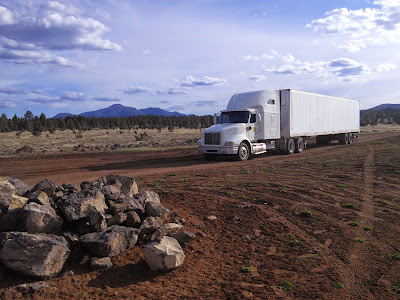From the time I've been streaming video to
Camstreams, I've enjoyed unlimited internet with
Millenicom as my broadband reseller. Their unlimited plans were the only game in town while providing their customers with the best equipment I've seen. Millenicom's gateway was Sprint. Then Sprint cancelled their contract with Millenicom. Millenicom's gateway became Verizon. Millenicom sent us a Novatel MiFi so I remained with their service using the Novatel device. After Verizon became Millenicom's gateway, service became restricted. Then, all of Millenicom's customers were handed over to Verizon. Now, as Verizon customers, our plan restricts us to 20 GB per month.
In the past, I've enjoyed unrestricted access to the internet and with
Camstreams I was arguably among the world's first
truck cams. With a web cam mounted to the top of the passenger seat of my truck, I broadcast 24/7.
My Cradlepoint router has a data usage monitor, a bean counter that tallies the bytes used. Now I'm chasing the devices using data, shutting them down and restricting their access.
While the telecoms tout speed, they restrict access. Less for more $$$ seems to be the way of things.
NAS,
DLNA,
UPnP,
Chromecast and
HTPC
Perhaps it's just the natural evolution of things, but my interest in computers includes
intranet. It's not enough to have a tablet, laptop, PC and MAC, but they must be able to share files. The easiest way to share files among your different devices is by building a network that includes storage. My first network storage device was a
DSM-G600. The DSM-G600 is now backup for my NAS.
A couple years ago I bought a
Nexus 7, but only a few months ago I purchased a Chromecast. I plugged the Chromecast into an open
HDMI port on my television and could then cast my Nexus screen to the television. The other HDMI port was being used to watch our huge collection of DVD's, but it occurred to me I should be able to cast movies from my Nexus and with the help of
BubbleUPnP, it worked!
Star was working on a book from her laptop. She has a collection of books she has been working on for the past 30 years and in the event her laptop crashed her work would be lost. As it turned out, only about a month after I added a NAS to our network, her laptop crashed! She was able to recover her work to a new computer her kids sent her from our NAS. In the meantime, I've been
ripping our DVD's to the NAS. However playing movies from my Nexus and casting them to a 42 inch high definition television is a lot to ask from a tablet! Windows Media Player from Jewel's new laptop worked like a charm.
But that wasn't enough. The media bug had bit. Although I've known about DLNA, HTPC's and UPnP for a long time, it wasn't until I got a NAS and began streaming movies from it, that it occurred to me why I'd want all that stuff.
About a week ago, I received a barebones mini PC I mail ordered from China. I was doing my research and discovered that although something like a
Raspberry PI could work as a HTPC, Windows Media Player was much easier to configure. I used the hard drive from Jewel's destroyed laptop that had Windows installed on it, on the new mini PC. Now our net is working and we have a spare PC in the event Jewel's laptop goes kablooey.



































